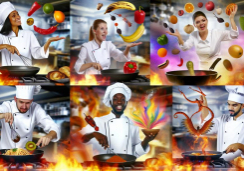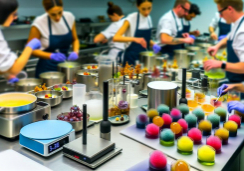Mastering Gluten-Free Baking: Fresh Recipe Innovations
As you stand before the vast sea of gluten-free flours, each promising a triumphant escape from the dense and crumbly disasters of the past, it's clear that the art of gluten-free baking is both nuanced and evolving.
You're aware that mastering this craft requires more than just substituting wheat flour with its gluten-free counterparts; it demands an understanding of how different ingredients interact to create the perfect rise, the right texture, and that ever-elusive flavor that can make or break a baked good.
With a plethora of innovative binding agents and leavening techniques at your fingertips, you're on the brink of transforming gluten-free baking from a mere alternative to an equal contender in the culinary world.
But as you sift through the pages of fresh recipe innovations, you'll find that the secret ingredient in mastering gluten-free baking might just be knowledge itself, leaving you to wonder: What culinary breakthroughs await those who dare to explore the subtleties of these flour blends and techniques?
Understanding Gluten-Free Flours
Diving into the world of gluten-free flours, you'll discover that each type offers unique qualities essential for crafting the perfect bake. Contrary to what some may believe, not all gluten-free flours are created equal; each has its own nutritional profile and baking properties.
Rice flour, for example, is a versatile staple that provides a neutral flavor, while almond flour is rich in protein and healthy fats, lending a moist texture and nutty taste to your creations.
You'll find that coconut flour, which is highly absorbent, requires more liquid to prevent a dry outcome. This feature makes it ideal for recipes that benefit from increased moisture. On the other hand, sorghum flour, known for its mild taste, closely mimics the texture of traditional wheat flour, making it a favorite for bread and pastries.
Embracing gluten-free flours means exploring a world where traditional wheat flour isn't the only option. It's about learning the unique behaviors of flours like quinoa, which can impart an earthy flavor, or tapioca, which offers a chewy quality to your bakes.
Innovative Binding Agents
While exploring the distinctive qualities of gluten-free flours is crucial, it's equally important to consider the role of innovative binding agents that give structure and texture to your gluten-free baked goods. As you master gluten-free baking, you'll discover that conventional binders like eggs aren't your only option. In fact, there's a world of psyllium husk alternatives and unconventional binders that can elevate the nutritional profile of your creations while ensuring they hold together beautifully.
- Psyllium Husk Alternatives: Flaxseed meal and chia seeds not only act as fantastic binders but also contribute valuable omega-3 fatty acids.
- Unconventional Binders: Aquafaba, the liquid from canned chickpeas, is a surprising yet effective binder, especially in vegan and egg-free baking.
- Creative Binding Techniques: Using gelatin, agar-agar, or pectin can introduce new textures and allow for experimentation in gluten-free recipes.
Each of these options offers a unique benefit. For instance, aquafaba whips up like egg whites, perfect for airy confections. Meanwhile, gelatin and its plant-based counterparts, agar-agar and pectin, can add a chewy or jelly-like consistency, expanding the realm of gluten-free desserts.
Embracing these innovative binding agents and creative binding techniques can lead to delightful and nutritious baked goods that everyone can enjoy.
Perfecting Gluten-Free Leavening
To perfect your gluten-free baked goods, it's essential to grasp the nuances of leavening agents like baking powder and baking soda, which are pivotal in achieving the right rise and texture. Rise optimization hinges on the precise balance and reactivity of these agents within your recipes. Gluten-free flours often require a tailored approach to leavening techniques to compensate for the absence of gluten's structural benefits.
You'll find that experimenting with ratios of baking powder or soda can significantly enhance the final product. However, troubleshooting leavening issues often means looking beyond the usual suspects. For instance, incorporating air into your batters through beaten egg whites or whipped aquafaba can lend a desirable lightness, mimicking the airy quality traditionally provided by gluten.
In the case of gluten-free breads, yeast still plays a traditional role, but it may call for supplementary ingredients, such as xanthan gum or psyllium husk, to reinforce the dough's structure. Moreover, the timing and temperature when activating these leavening agents are critical—too hot, and you risk deactivating the yeast; too cold, and the rise might be lackluster.
Can I Use Fresh Recipe Innovations to Improve My Gluten-Free Baking?
Yes, you can definitely use fresh recipe innovations to improve your glutenfree baked goods recipe. Incorporating new techniques and ingredients can help enhance the texture and flavor of your gluten-free baked treats. Experimenting with different flours, binders, and flavorings can result in delicious and unique gluten-free baked goods.
Flavor Enhancements in Gluten-Free
Beyond mastering the rise and texture of your gluten-free creations, it's equally important to enhance their flavor profile, ensuring each bite is as delicious as it's nutritious. Using natural extracts, like vanilla or almond, adds a layer of complexity that can elevate your baked goods from good to great. Experimenting with different oils, such as coconut or walnut, can't only improve the taste but also contribute beneficial fats to your diet.
Incorporating herbs and spices is a smart way to infuse flavor without compromising on health. Here are some innovative ways to boost the flavor in your gluten-free baking:
- Experiment with Flour Varieties: Each gluten-free flour has a unique taste. Almond flour can impart a nutty flavor, while buckwheat flour might add an earthy note.
- Natural Sweeteners: Swap out traditional sugar for honey, maple syrup, or agave nectar to add a rich, nuanced sweetness.
- Fruit and Nut Add-Ins: Fresh fruits, nuts, and seeds offer bursts of flavor and texture, making each bite a delightful experience.
Textures and Consistencies Mastery
Mastering the textures and consistencies of gluten-free baked goods often hinges on the careful selection and combination of various flours and binding agents. Understanding ingredient substitutions is crucial to your success. Different gluten-free flours possess unique properties that can significantly affect the final product. To achieve light and airy textures, you'll need to get familiar with the behavior of each flour type and learn how to manipulate these ingredients skillfully.
Xanthan gum and guar gum are your allies in avoiding common texture issues, such as crumbliness or density. These binding agents emulate gluten's structural functions, providing elasticity and stability to your creations.
Don't underestimate the power of extra moisture too; it combats the inherent dryness often found in gluten-free baked goods. Incorporating ingredients like apple sauce, yogurt, or buttermilk can help maintain a tender crumb.
Conclusion
You've journeyed through the art of gluten-free baking, discovering how to wield flours and binders with finesse.
Now, with innovative leavening techniques and flavor enhancements at your fingertips, you're set to create masterful textures and tastes that defy the grain-free norm.
Your baked goods won't just nourish—they'll impress.
Embrace this culinary innovation, and watch as your precision in the kitchen brings about a revolution in gluten-free indulgence.
Bake on, health-conscious connoisseur!










